How to Grow Your eCommerce Business in a Recession
How to Grow Your eCommerce Business in a Recession
In challenging times, the fear of uncertainty often causes consumers to become more conservative and risk-averse - taking more precautions than normal to ensure that they’re making good purchase decisions.
In order to build confidence in their buying decisions, consumers start to focus on two main factors when making online purchases: trust and value.
- Can they trust the website they’re buying from to effectively deliver the product or service they need?
- And, is the product or service they’re buying going to give them the most value for their money? Although trust and value are always important conversion drivers, they become even more relevant and influential in tough times, when people are less likely to take risks.
In soft economies consumers are going to be more cautious with their money, while they scrutinize every purchase and value proposition while looking for more, credible trust signals than normal to offset their increased anxiety and concern.
So when times are tough, people will ultimately buy from the vendor that offers them the highest sense of security, confidence, and value.
History Teaches Us a Valuable Lesson
Throughout all 23 recessions since 1902, the pattern and results have remained the same...
About 75% of companies will reduce or eliminate marketing following the recession, and over 2/3rd’s of those companies will never regain the market share and profitability they lost during the recession. The majority in this category reach a new and sustained low.
Alternatively, the other 25% of companies see an opportunity to expand market share in a recession by maintaining or even increasing their marketing and advertising efforts. And over 2/3rd’s of these companies will see additional growth for 5 years after the recession. The majority in this category reach a new and sustained higher growth rate. And many have gone on to become the dominant leader in their category, by seizing the day, and choosing to innovate and grow.
During my career, I have studied and researched reams of data, case studies, and reports from academia and corporations alike that have taken place over many decades of booms and recessions, and ultimately it all boils down to 4 key action steps that separate the winning companies from the losers.
Here are the 4 Most Effective Ways To Help Your Ecommerce Business Thrive in A Recession:
-
- Increase Visibility - remain visible, active and relevant in the market. Stay in front of your target audience by advertising and marketing, but change your messaging so that your product or service becomes a needed solution to the problems or circumstances that your potential customers are currently facing.
- Add More Value - become the obvious choice and give customers every reason to choose you by giving more. In uncertain times, people are looking for more value and the highest return on their investment (ROI) possible. They want to be sure that they are getting a great deal and value exchange for their money.
Some innovative ways to add more value include:- Free info products that help them to solve a problem or to get more value out of their purchase
- Free upgrades
- Introductory pricing
- Delayed billing
- Sales or discounts
- Free shipping
- No sales tax
- Extended warranties or guarantees
- BOGO offers
- Extended online support
- A free user community
- Free accessories or bonus products bundled with the main product
- Establish Trust - throughout the entire sales funnel (off-site, on-site, and at checkout) to increase more Visibility, Clicks, and Conversions.
The most effective ways to establish online trust are through trusted 3rd party solutions that provide your company with:- Social Proof (from verified and authentic customer ratings and reviews)
- Security (through a security solution that provides a trusted Security seal)
- Validation (typically through a BBB membership or other credible 3rd party memberships, awards etc.)
- Eliminate Risk - remove or mitigate as much risk as possible for the consumer after the sale.
The best way to eliminate risk after the sale is to offer things like- Guarantees
- Warranties
- Free return shipping
- Stellar customer support
- Increase Visibility - remain visible, active and relevant in the market. Stay in front of your target audience by advertising and marketing, but change your messaging so that your product or service becomes a needed solution to the problems or circumstances that your potential customers are currently facing.
By increasing your visibility, adding more value, establishing trust, and mitigating risk, you are positioning yourself in the best possible way for success. While it may still be challenging during the downturn, your ability to weather the storm will increase significantly; and then, once the economy starts to improve, you’ll be ahead of the curve, and primed for rapid growth.
Why You Should ‘Stay In The Game’
While it is incredibly tempting to cut back on advertising, you must be visible by the market in order to be seen as a relevant option, so one of the worst things you can do is to put down your megaphone and stop advertising, promoting, and marketing. In fact, recession history tells us that most marketers stop or reduce their marketing efforts in uncertain times, which means those who stay in the game, have less competition and lower ad costs.
Neil Patel, an SEO and online marketing expert made this statement in his newsletter dated 3/17/20:
“What I’ve learned from going through two crashes (the dotcom crash in 2000 and the real estate crash in 2008) is that the best time to double down is when others are not.
During an economic downturn, you’ll find that you will have less competition, which means it is easier and faster to get results, and in some cases, you’ll be able to get deals, such as a potential reduction in pay-per-click advertising.”
And the Harvard Business Review said this about the opportunities created in recessionary periods:
“The rationale that a company can afford to cut back in advertising because everybody else is cutting back is fallacious. Rather than wait for business to return to normal, executives should cash in on the opportunity that rival companies are creating for them.”
The McGraw-Hill Research Laboratory of Advertising Performance followed the performance of 600 industrial companies for 6 years from 1980 to 1985 in connection with the 1981-82 recession, and found the following:
“By 1985, sales of companies that were aggressive recession advertisers had risen 256% over those that didn't keep up their advertising.”
The Wharton School of Business also supports this premise in their research findings:
“If companies cut deeply into advertising and communications in a down period, the cost to regain a share of voice in the market once the economy turns around may cost four or five times as much as the cuts saved.”
Bain & Company analyzed over 700 firms over a six-year period and found that:
“Twice as many companies made the leap from laggards to leaders during the 1990-91 recession as during surrounding periods of economic calm.
Of the firms that made major recession period gains in revenue or profitability, more than 70% sustained those gains through the next boom cycle. And less than 30% of those that cut back and lost ground were able to regain their positions.
Such opportunities always exist for strong, focused companies, but the impact of exercising them is much higher during a recession when many competitors are either distracted or hibernating.”
In their joint 1993 report following the 1990-91 recession, the accounting firms of Coopers and Lybrand and Price, Waterhouse, Coopers stated:
“Businesses that maintain aggressive marketing programs during a recession, outperform companies that rely more on cost-cutting measures. A strong marketing program enables a firm to solidify its customer base, take business away from less aggressive competitors, and position itself for future growth during the recovery.”
MarketSense Research compared 101 household name brands during the recessionary period of 1990 to 1991, who then concluded in their study of recessionary marketing best practices based on those companies who performed the best:
“The best strategy for coping with a recession is balanced ad spending for long-term consumer motivation, plus promotion for short-term sales boosts.”
Famous Case Studies - Winning Market Share in a Down Economy
These studies of recessionary marketing habits have been played out by some of the most successful brands in history, although going into their first recession they did not start out as market leaders.
For example:
- Beginning with the Great Depression, while other competitors cut ad budgets, P&G increased its ad spending. And in every recession since then, P&G has gained market share. The term “Soap Opera” came from the 1930s when Procter & Gamble became the sole sponsor of the popular daytime radio programing.
- During the 1920s, Ford was outselling Chevrolet by 10 to 1. In 1929, in spite of the Depression, Chevrolet expanded its advertising budget while Ford cut back, and by 1931 (just 2-years later) Chevrolet took the lead.
- Both Kellogg’s and Post were racing neck and neck to dominate the breakfast cereal category in the 1920s. When the Great Depression hit, Post Cereal cut their ad budget, while Kellogg’s increased theirs by one-million dollars. Kellogg’s upward sales curve continued right through the Depression, and profits improved from around $4.3 million a year in the late 1920s to $5.7 million in the early 1930s. When the depression ended, Kellogg’s emerged as the dominant, and most profitable breakfast cereal brand - a position they have maintained to this day.
- In 1990, Nike and Reebok were virtually tied for first place in sales. During the 1990-91 recession, Nike tripled its advertising spending, while Reebok cut back. When America emerged from the recession, Nike's profits were nine times higher than they were going in - and Reebok has been a distant competitor ever since.
The lesson to learn here is that it’s not always what the recession does to you - it’s often how you react to it that counts.
How to Add More Value and Create an Effective Value Proposition
Standing out from the competition in a meaningful way, that the target market cares about and is willing to pay for, is very important. If they don’t clearly see, understand and value your value proposition, then it isn’t one.
The acid test is this: Ask yourself these two questions honestly and objectively, “Why would someone buy from you, rather than the competition?” And, “Are the reasons why someone should buy from you over your competition, crystal clear to the buyer?” What makes you different and attractive to your ideal customer should be easy for them to recognize and understand, and if necessary, supported by evidence, data, or claims that your competitors cannot also claim or support. This must be a unique value proposition that you and only you can offer.
However, if your competitor also offers the exact same product or service, you can always create a unique value proposition by inventing a ‘value add’ - like offering a free bundled item with purchase, a better guarantee, expedited shipping, price match guarantee, free shipping insurance, etc.
Even More Case Studies - with Pictures!
Hyundai and GM
For example, Hyundai’s recession strategy has always been to add more value in challenging times by offering economic peace of mind. In the 2008 recession, they came out with a marketing strategy that said, “You can return your new car if you lose your job within one year of buying it.” This risk reversal strategy turned out to create a big boost in sales. So much so, that GM soon followed suit.
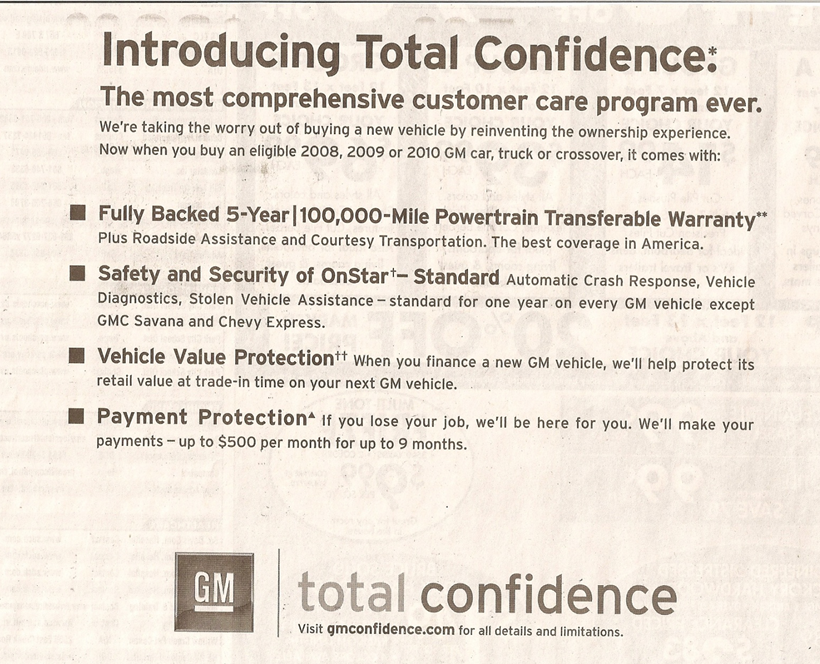
During the 2008-2010 recession, GM dramatically improved their value proposition and peace-of-mind that they offered to their customers by creating the “GM Total Confidence” package, that included an extended warranty, protecting the value or depreciation of the vehicle, as well as job loss protection.
Hyundai also increased its value proposition to offer more reliability and peace of mind with the industry's first 10-year, 100,000-mile warranty. As a result of adding value and peace of mind in an uncertain time, Hyundai sales were up 14% in January ‘09, at a time when other manufacturers were down as much as 32%. This put Hyundai in such a dominant position that they were able to buy their competitor Kia. And to this day, Hyundai is a major player in the automotive scene.
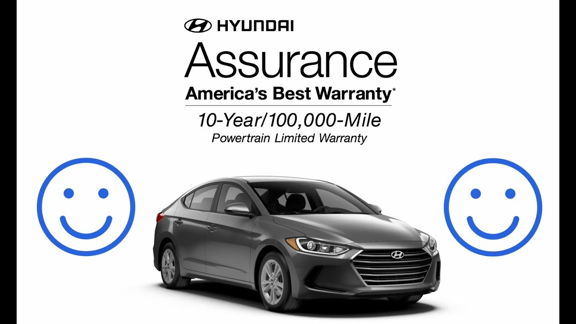
Kellog’s
The Kellog’s Depression strategy included several unique ideas, that all combined to add more value, including:
- Sampling (Risk Reversal)
- Coupons (Discounts)
- Free Gifts (Extra Value)
- Free Recipe Guide (New uses for an existing product)
Here’s how Kellogg’s did it:
- They started running radio and print campaigns promoting a free sample size box of Corn Flakes, which also created Top Of Mind Awareness (TOMA), which is an important component of creating brand trust, credibility and preference.
- Inside every sample box was a special coupon that they could use to buy a full-size box the next time they went to the store.
- Inside each full-size box of Corn Flakes, they included free gifts. One of these gifts that really took off as a free measuring cup and recipe guide.
The recipe guide was a stroke of genius because it showed consumers how to stretch their food budget with 100 ways to use Corn Flakes as a low-cost meal extender. This free gift not only increased sales of the initial purchase, but it also increased repeat sales many-fold, because it showed people how to use more of the product effectively to squelch a real need (more recipe variety, taste, and value on a limited budget). Many popular dishes that we eat today still use Corn Flakes in them and are a result of this 1930’s campaign.
Kellogg’s was the first company to put free value-added gifts inside their packaging to encourage sales. In addition to the measuring cup and recipe book, they were also the very first to include a free children’s toy. In the 1930’s it was a series of small children’s books.
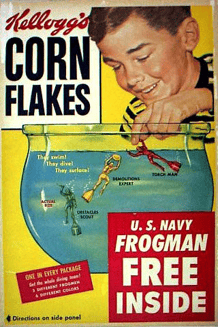

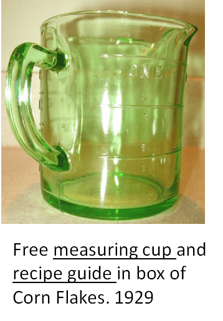
A.1. Steak Sauce
During the 1990-91 recession, A.1. repositioned its famous steak sauce to “hamburger enhancer”, and their ads included recipes for how to use A.1. in various low-cost hamburger dishes that didn’t look or taste like a boring hamburger recipe.
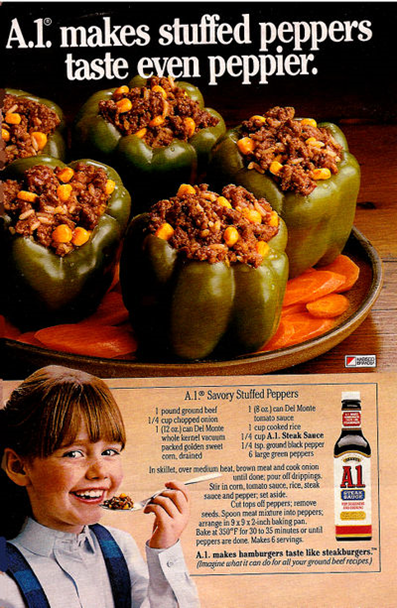
SPAM
And SPAM created a campaign that showed consumers all the many ways they could replace traditional, more expensive meats with their lower-cost alternative, and supported it with the value prop statement “A lot of meat. But not a lot of money.”
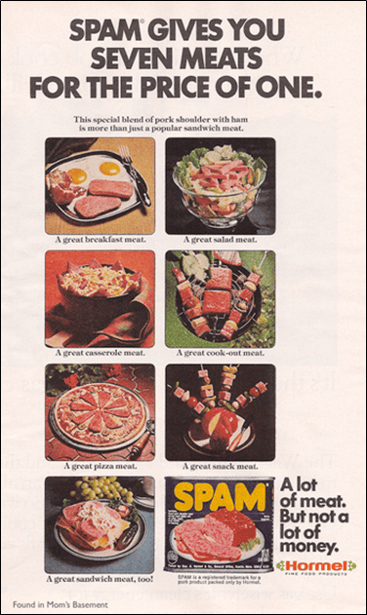
Quiznos
In 2009, Quiznos changed their homepage to feature a variety of value-added incentives, including:
- 37 menu items with new lower prices
- 20 subs under $5
- Enter to win a year of free subs
- Free sub coupon (when you provide your email address)
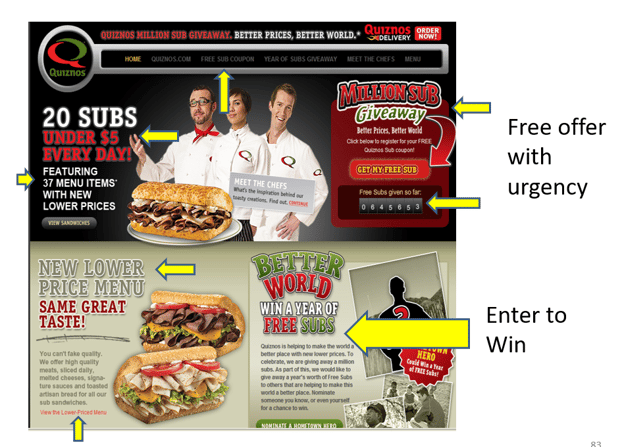
As you can see, each of these companies put in a lot of time and effort in coming up with creative marketing ideas and strategies that allowed them to add more value when people were looking for ways to stretch their dollar.
Keep in mind, that these value-added strategies will not only help retain your sales now, but they will propel you to ever greater heights in the post-recession, given the fact that you have gained brand preference now when it’s most critical, and when advertising rates will be at an all-time low.
Establish Trust and Eliminate Risk
When the economy is good, consumers are willing to take more chances on unknown vendors or products, but when the economy starts to turn, they become more cautious, and are less likely to spend their time and money on companies or products that they’re not familiar with, or that have a perceived risk of not being trusted, safe, or unable to deliver on their promises. However, when that risk is mitigated or removed, their confidence significantly increases and they’re much more willing to buy.
For most businesses, the fastest way to eliminate risk is by establishing trust through 3 well-proven, time-tested solutions that provide Social Proof, Security, and Validation (IE. Ratings and reviews, security seals, and the BBB).
The #1 most effective way to establish trust is through ratings and reviews. Reviews, or Social Proof, have been proven as the leading point of persuasion by research from Google, Dr. Robert Cialdini, and the leading experts in CRO (Conversion Rate Optimization) and behavioral science.
Collecting reviews from a Google Review Partner like Shopper Approved is particularly beneficial because the are syndicated to Google, allowing them to appear in your Google ads, Google Shopping, and your organic search results.
The reason ratings and reviews are so effective is because they are low in cost, they are the only form of social proof that positively impacts every single aspect of the sales funnel (Off-Site (SEO and search results), On-Site (home page, product pages, and Checkout), and they positively affect every key performance metric, including: Cost-Per-Review (CPR), Cost-Per-Impression (CPI), Cost-Per-Click (CPC), Click-Through Rate (CTR), Cost-Per-Lead (CPL), Conversion Rate (CR), Average Order Value (AOV), Return On Ad Spend (ROAS), and Customer Acquisition Cost (CAC) - all of which have a direct, positive impact on your sales, profits and sales margin.
One of the reasons why ratings and reviews are so effective is because Google places a lot of emphasis on them - particularly the Star rating and the total number of reviews - throughout their entire search engine. These ratings have a direct positive impact on every single search listing or paid ad that they are displayed next to. Star ratings increase visual acuity (visibility), because the human eye is naturally drawn to the ads with stars, which directly correlates to an increase in your Click Through Rates (CTR) by an average of 17% according to Google. Our clients report a 20% increase.
Here are some examples of where Star ratings appear in a Google search:
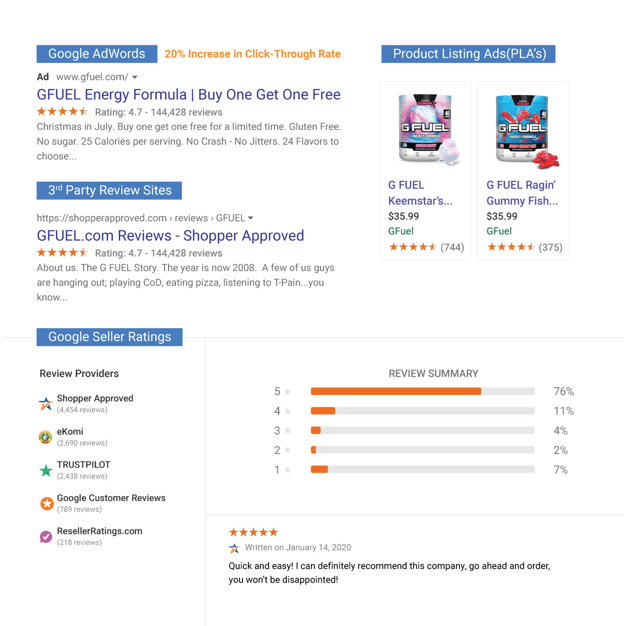
In addition to the above examples, they also appear in Google Shopping search results, and Google Shopping product pages in the form of green percentages, like the examples below:
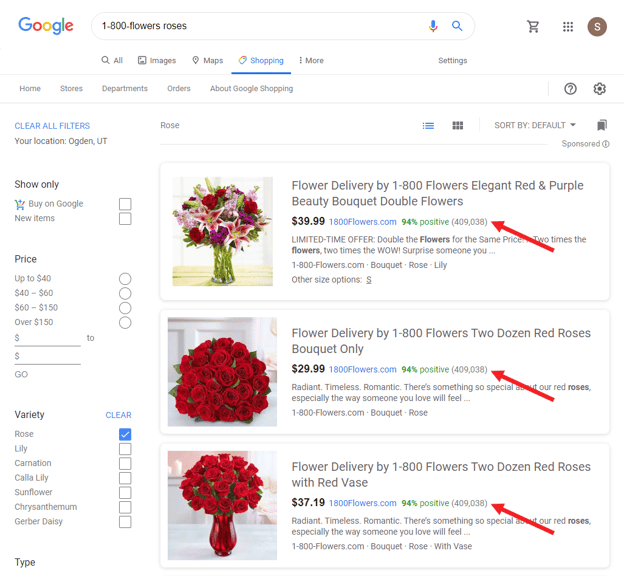
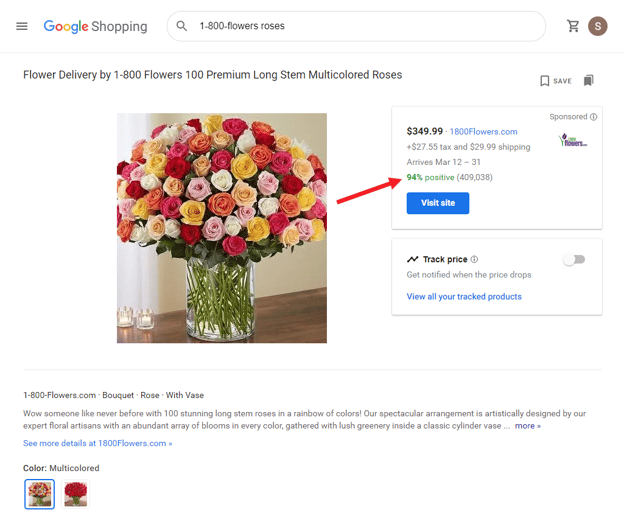
Once a customer has clicked through from Google to your website, you can use ratings and reviews to further increase trust and credibility by adding review widgets to your website and product pages, like in the examples below:
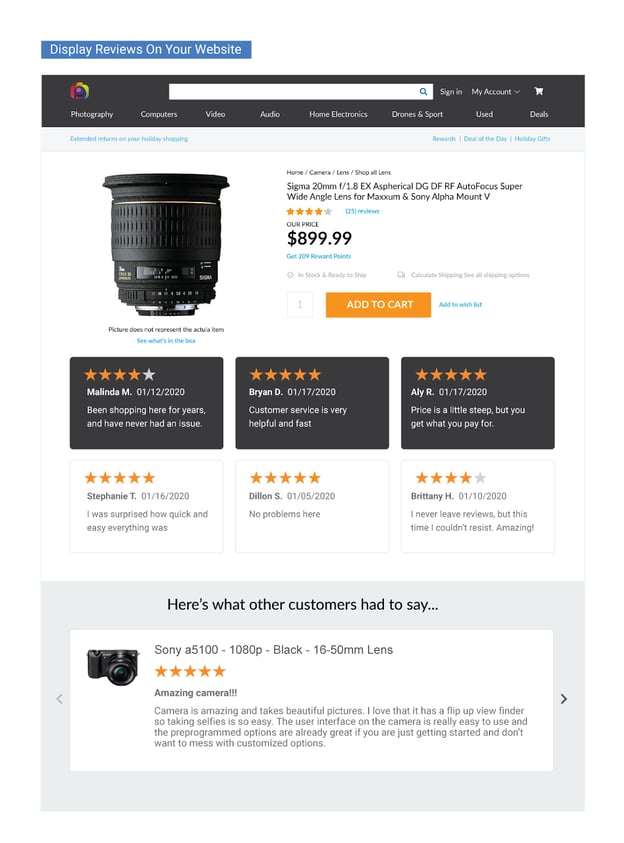
By adding social proof in the form of ratings and reviews at every critical decision-making point throughout the funnel, you are able to ‘Attract’ new potential customers in Google, ‘Convince’ them to buy from you on your website, and ultimately ‘Convert’ them into buyers.
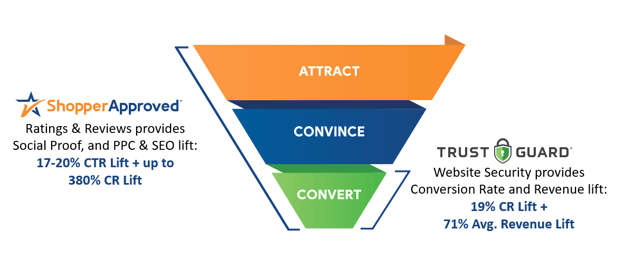
Social proof and website security seals directly improve the key
performance metrics throughout the buyer journey
The #2 way to establish trust is by adding a Security seal, like Trust Guard, throughout your website, and most importantly to your checkout pages. This is extremely important in times of uncertainty, because consumers need reassurance that their personal and payment information is going to be safe and protected, and adding a Security seal, specifically made for this purpose, can eliminate safety concerns, and create peace of mind - right when it’s needed the most.

The Trust Guard Security Seal on your Checkout Page improves Conversions and AOV
by offering your customers greater peace-of-mind
Statistically, 70% of all buyers abandon the shopping cart, just moments before they buy, so by resolving their security concerns, at the very moment they are asked to pull out their credit card, you significantly lower cart abandonment and increase your Conversion Rate (CR) and your Average Order Value (AOV).
The third way to establish trust is through adding business validation and accreditation by becoming a member of the Better Business Bureau (BBB). The BBB has been around for over 100 years, and is well known for their ability to verify and validate businesses. By adding a BBB logo to your website, you show that you’ve been vetted, and that you can be trusted.
In addition to Establishing Trust, the other effective way to Eliminate Risk is by giving consumers peace of mind through assurances after the sale; using things like money-back guarantees or free return shipping.
For example, in the case studies mentioned earlier, Hyundai removed the risk of buying their vehicles in a recession, by offering both a buy-back guarantee and an extended warranty. This strategy increased their sales and market share when everyone, including themselves, was struggling. It’s innovative ideas and creative thinking like these, when the chips are down, that really help good businesses become great!
How To Add More Value To Your Website
With Trust Guard Total Website Protection, you get three powerful layers of protection to help defend your website from hackers, while improving your conversion rate, and your average order value (AOV).
The best way to think of Total Website Protection is to compare it to Fort Knox. The first layer is daily PCI Scanning, which acts like the external defenses and walls, keeping threats out. The second layer is daily Malware Scanning, which acts like security guards inside the building, watching out for bad guys that get past the external defenses. The final layer is SSL, which acts like armored trucks that securely transport valuable content to the bank and back.
Trust Guard is the only website security solution that offers all three types of protection in one solution.
The Trust Guard Checkout Seal typically goes under the ‘Checkout’ button. On mobile devices, it looks like the image below (bottom left-hand side)...
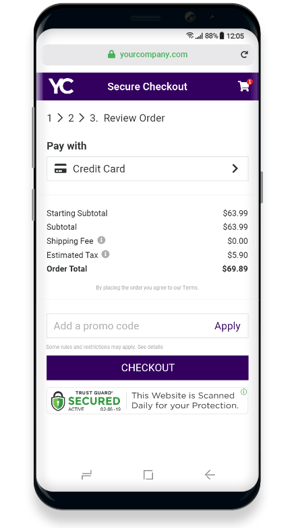
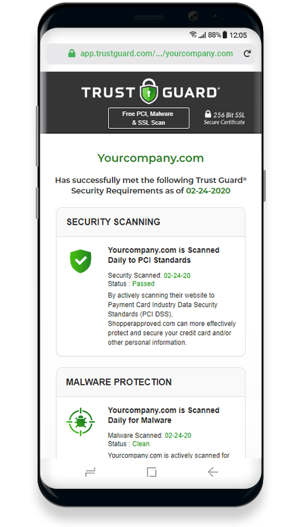
Then, if a customer clicks on the seal, they go to a Trust Guard Certificate page that shows them what security measures you’ve taken to secure your website and protect their information (right-handed side).
On the desktop example below, you can see both the main Trust Guard SECURED seal, and the Trust Guard Checkout seal. The SECURED seal typically goes on the homepage and landing pages, whereas the Checkout seal is targeted towards product pages, the shopping cart and checkout pages, where customers need the most reassurance and are the most likely to abandon their purchase.
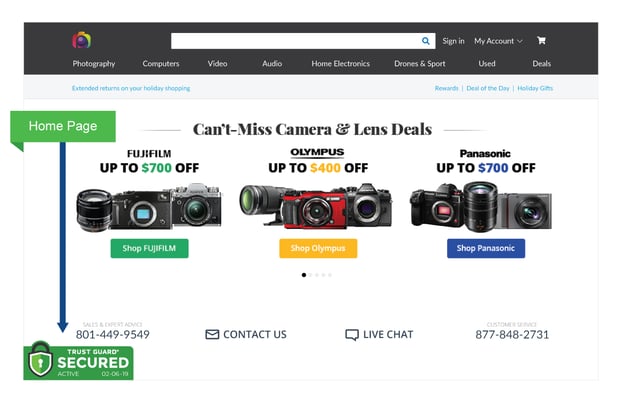
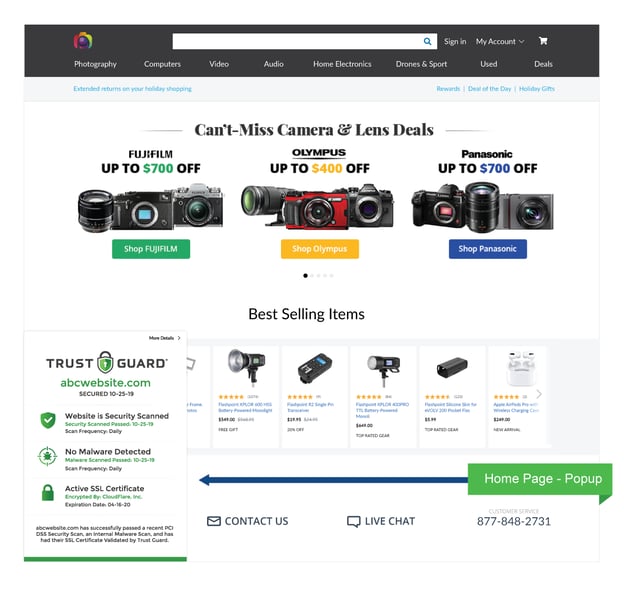
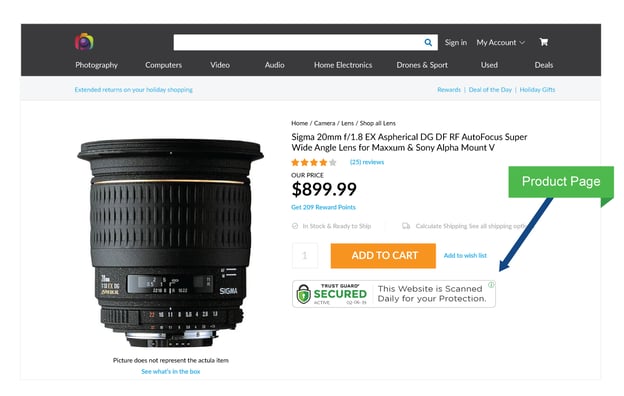
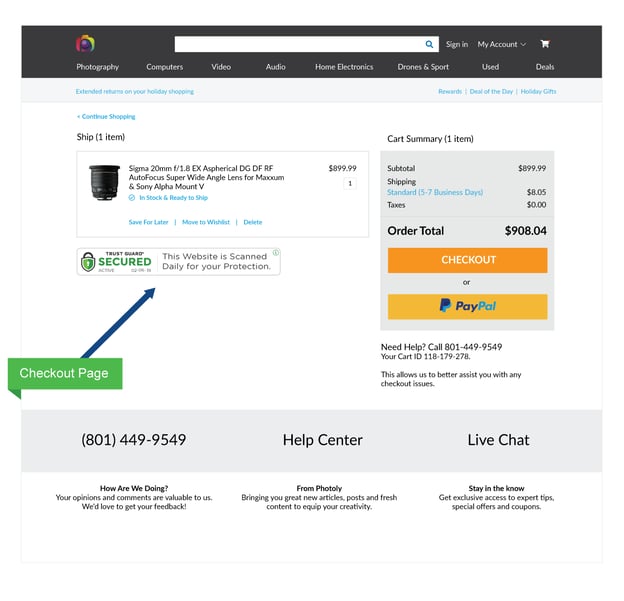
Trust Guard seals have been independently tested by Conversion Fanatics, and shown to increase online conversion rates by 19.2% and average revenue per visitor by 71.1% when properly used and displayed.
Summary
Many businesses are going to be challenged over the coming months, and depending on what they sell and who they sell to, and how they address their marketing and value proposition, some will win big, and some will be faced with more difficult decisions on how to stay relevant.
However, there is enough data to support the fact that virtually anyone can significantly improve their marketing metrics and sales both now, and especially after a recession, if they execute these timeless strategies of adding more value in their messaging and offerings, and providing more trust and social proof throughout the customer journey.
To learn more about Shopper Approved or to get a free trial click here.
Other posts by DJ Sprague
- How to use the Google Search Quality Evaluator Guidelines to Improve SEO and Traffic
- How to Optimize SEO with UGC
- How and Why To Get More Positive Online Reviews for Your eCommerce Store
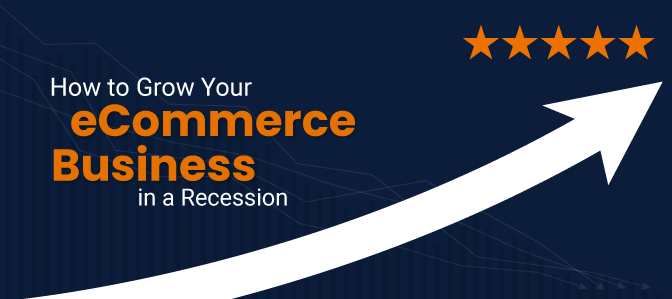
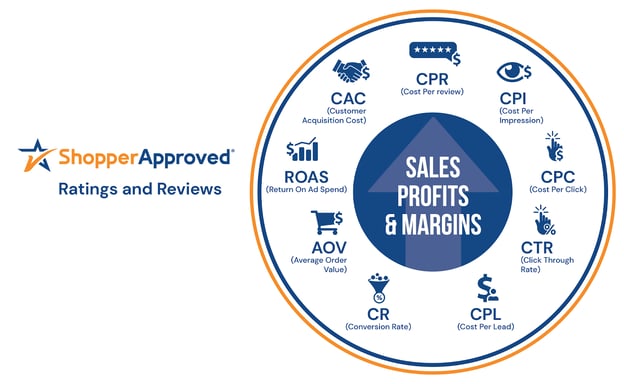
 Drive More Visibility, Traffic, and Sales
Drive More Visibility, Traffic, and Sales
